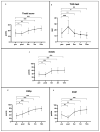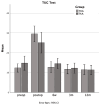Balance and Mobility in Comparison to Patient-Reported Outcomes-A Longitudinal Evaluation After Total Hip and Knee Arthroplasty
- PMID: 40565883
- PMCID: PMC12193784
- DOI: 10.3390/jcm14124135
Balance and Mobility in Comparison to Patient-Reported Outcomes-A Longitudinal Evaluation After Total Hip and Knee Arthroplasty
Abstract
Background: Balance and gait are critical for functional recovery and fall prevention following total hip (THA) and knee arthroplasty (TKA). Despite improvements in pain and joint function, residual impairments often persist. The Timed Up and Go (TUG) test and Tinetti Performance-Oriented Mobility Assessment (POMA) objectively measure postoperative mobility and balance, while patient-reported outcome measures (PROMs) assess perceived function and well-being. This study longitudinally evaluates functional measurement and PROMs to explore their interrelationships and compare recovery trajectories in THA and TKA cohorts. Methods: In this prospective study, 22 THA and 21 TKA patients were assessed preoperatively and at 4-6 days, 6 weeks, 3 months, and 12 months postoperatively using TUG, Tinetti, Hip Disability and Osteoarthritis Outcome Score (HOOS), Knee Injury and Osteoarthritis Outcome Score (KOOS), and clinical scores (Harris Hip Score (HHS) for THA, Knee Society Score (KSS) for TKA). Pearson correlation assessed relationships between measures. Results: Both cohorts demonstrated significant immediate postoperative declines in balance and mobility, recovering to baseline by 6 weeks and surpassing it by 3 and 12 months (p < 0.001). PROMs showed earlier and sustained improvements. Objective balance and mobility measures showed minimal correlation with PROMs but were highly interrelated from 6 weeks onward. Conclusions: THA and TKA patients experience early postoperative balance impairments, suggesting heightened fall risk, with functional recovery lagging behind perceived well-being, highlighting the need for cautious rehabilitation strategies.
Keywords: Tinetti performance-oriented mobility assessment; balance; mobility; patient-reported outcome measures; recovery; total hip arthroplasty; total knee arthroplasty.
Conflict of interest statement
Each author certifies that there are no funding or commercial associations (consultancies, stock ownership, equity interest, patent/licensing arrangements, etc.) that might pose a conflict of interest in connection with the submitted article related to the author or any immediate family members. M.W. reports honoraria for lectures and course instruction from Arthrex Inc. all of which are not related to this study. R.W. reports consulting fees from Johnson & Johnson, Medical Limited, Stryker European, and Operations Limited, and institutional agreements between the Medical University of Vienna and De Puy Synthes, Johnson & Johnson, all of which are not related to this study. C.B. reports honoraria for lectures and course instruction Johnson & Johnson and Medacta.
Figures




Similar articles
-
Assistive devices, hip precautions, environmental modifications and training to prevent dislocation and improve function after hip arthroplasty.Cochrane Database Syst Rev. 2016 Jul 4;7(7):CD010815. doi: 10.1002/14651858.CD010815.pub2. Cochrane Database Syst Rev. 2016. PMID: 27374001 Free PMC article.
-
Does Physical Activity Increase After Total Hip or Knee Arthroplasty for Osteoarthritis? A Systematic Review.J Orthop Sports Phys Ther. 2016 Jun;46(6):431-42. doi: 10.2519/jospt.2016.6449. Epub 2016 Apr 26. J Orthop Sports Phys Ther. 2016. PMID: 27117726
-
Efficacy and safety of bicompartmental versus total knee arthroplasty for treating medial tibiofemoral compartment combined with patellofemoral compartment osteoarthritis: a systematic review and META-analysis.Int J Surg. 2025 Jun 27. doi: 10.1097/JS9.0000000000002885. Online ahead of print. Int J Surg. 2025. PMID: 40576190
-
Increased complications rates and inferior patient reported outcomes following total knee arthroplasty due to post-traumatic osteoarthritis with previous fracture treatment: a systematic review.Knee Surg Sports Traumatol Arthrosc. 2023 Oct;31(10):4124-4141. doi: 10.1007/s00167-023-07407-x. Epub 2023 Apr 25. Knee Surg Sports Traumatol Arthrosc. 2023. PMID: 37097470 Free PMC article.
-
Association Between Tourniquet Use and Patient-Reported Outcomes Following Total Knee Arthroplasty: A Multicenter Comparison.J Bone Joint Surg Am. 2025 May 7;107(9):976-984. doi: 10.2106/JBJS.24.00266. Epub 2025 Mar 20. J Bone Joint Surg Am. 2025. PMID: 40112083
References
-
- Benedetti M.G., Di Martino A., Bonsanto F., Sommella N., Ciardulli F., Labanca L. Balance and proprioception impairment, assessment tools, and rehabilitation training in patients with total hip arthroplasty: A systematic review. BMC Musculoskelet. Disord. 2021;22:1055. doi: 10.1186/s12891-021-04919-w. - DOI - PMC - PubMed
-
- Fukushima K., Uchiyama K., Takahira N., Takaso M., Matsunaga A., Fukuda M., Nanri Y., Shibuya M., Kamiya K. The maximal gait speed is a simple and useful prognostic indicator for functional recovery after total hip arthroplasty. BMC Musculoskelet. Disord. 2020;21:84. doi: 10.1186/s12891-020-3093-z. - DOI - PMC - PubMed
-
- Eckardt A., Mündermann A., Nüesch C., Clauss M., Stoffel K., Pagenstert G., Kaufmann M., Ilchmann T., Ismailidis P. Functional assessment of total hip arthroplasty using inertial measurement units: Improvement in gait kinematics and association with patient-reported outcome measures. J. Orthop. Res. 2022;41:759–770. doi: 10.1002/jor.25421. - DOI - PubMed
LinkOut - more resources
Full Text Sources

